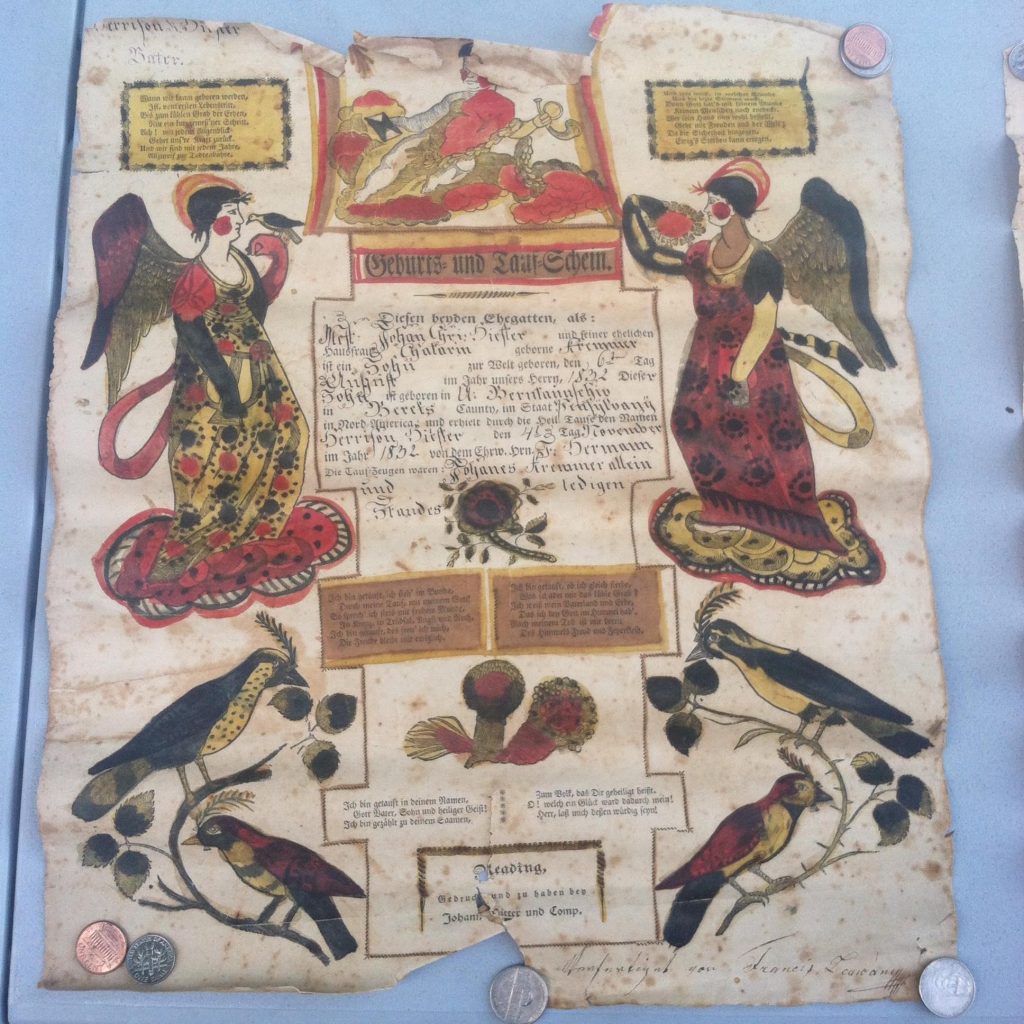Published August 1, 2022
| 3 Comments | Leave A ReplyA subject to which I never tire of returning is fraktur—especially the private decorative birth and baptismal certificates of the Pennsylvania Germans.

While my personal collection of such items is small, they are among my dearest possessions, which is probably due to the influence of one person whom I miss dearly: the late Corinne P. Earnest, who made fraktur her passion and guided me to the purchase of most of the samples I have from my own family.
The favorite of the ones I possess is a Taufschein (the German-language word for baptismal certificate) of my great-great-grandfather Harrison Hiester, with in-fill handwritten (and probably colored) by noted fraktur artist Francis Levan on a printed form from Reading’s Johann Ritter and Company.
I like the aesthetic of the way the print and handwriting combine as well as the somewhat garish coloring—which according to Earnest was a Levan trademark; I especially like the way he reddens the cherub’s chubby cheeks for emphasis—and it was part of a trove of fraktur I purchased from a dealer after being cued to their existence by Earnest, and so she lives on in my memory in this way.
In addition to the pure artistic appeal of the Harrison Hiester certificate, it’s filled with interesting information, some of it that can’t be found on any other contemporary document.
For instance, there are not good records for Bern Reformed Church in the time of Harrison’s 1832 birth, so this certificate showing it occurred on Aug. 6 is as good as it’s going to get.
And it’s interesting to see confirmed that what’s now known simply as “Bern Township” was then called “Lower Bern Township”—actually, it’s shown with the German abbreviation “U.” for Unter.
I also enjoy seeing the spelling variants for both personal and family names. Harrison’s mother Catharine Kramer Hiester, for instance, is identified as Chatarin and with the maiden surname Kremmer; all those are phonetic substitutions but still speak to the lack of standard spelling during that time.
Levan himself had the itinerant life led by many an artist—some say alcohol was a downfall for him!—and when he was found dead along a road in Berks County, his body was taken to the poorhouse for burial.
Harrison’s certificate would have been produced fairly early in Levan’s career, which Earnest indicates stretched from around 1826 to his death in 1850.
When compared with Harrison’s, his wife Rosabella Kerschner’s 1834 certificate is somewhat tame. Its in-fill is in a relatively plain script and the printed form appears to have been one that was machine-colored by the ground-breaking Harrisburg printer G.S. Peters (Also interesting is that she was baptized by a Lutheran minister, although her father Peter just a couple of years later would be a Reformed church trustee signing the agreement to make Bern a union church).
So much more to investigate, as always.


Catryna J Loos
2 years ago
I would love to see a photo of your fraktur !
James Beidler
2 years ago
I’ve updated the post with a photo of it!
Janet Rupert
2 years ago
I love fraktur as well and really miss Corinne’s great work collecting them. The phonetic spellings can be very interesting (and confusing). I inherited several fraktur certificates for my husband’s family, the phonetic spelling of one surname baffled me for a while. Emilia Henninger’s mother was listed as Hannah Meckefie, which I thought a rather odd German surname. More research revealed that Hannah’s maiden name was MacAfee. Apparently the German-speaking fraktur artist used his own phonetic spelling of that Scots surname. I’ve seen lots of German surnames Anglicized, but that was the first time I’d found an English surname Germanized.